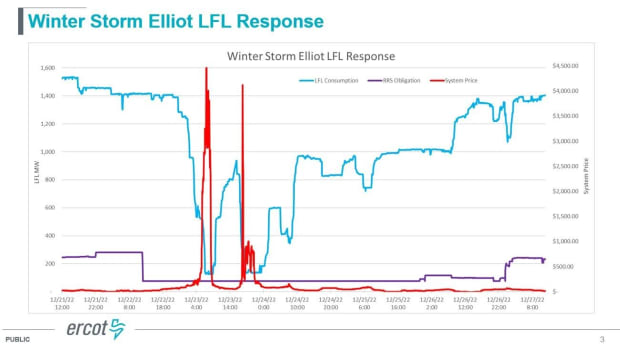A number of headlines just lately described a 25% drop in bitcoin community issue throughout Winter Storm Finn in January. Most attributed this drop to curtailment exercise in Texas. Whereas Texas does signify 17% of the worldwide bitcoin hashrate, ERCOT information reveals that a number of the curtailment exercise was a mixture of upper costs and “good grid citizenship.” In ERCOT, and to a lesser extent in different ISOs, costs are one of the best proxy for grid stress. There are different proxies akin to PRC (bodily responsive functionality) however costs are a greater measure for many conditions. For that motive, as a way to forestall swings in costs and create tougher gird circumstances, an optimum surroundings is one wherein the value doesn’t swing wildly up and down. Nonetheless, value volatility is a frequent incidence in ERCOT, as evidenced by Winter Storm Elliot in December 2022 (see graph under).
Bitcoin miners are the economically good customers of electrical energy. That’s not to say that bitcoin miners will devour electrical energy in an altruistic method, however somewhat that margins for bitcoin miners are uniquely delicate to the value of energy such that they’re economically incentivized to curtail consumption when energy costs exceed their breakeven threshold (present breakeven for many miners ranges between $100 and $200 per MWh). Which means they’ll devour electrical energy when costs are under their breakeven value and switch off when costs are above it. There are some operational and sensible exceptions to this, for instance, if miners have information heart colocation agreements that stipulate or assure uptime.
Texans ought to need bitcoin miners to be on anytime energy is plentiful as a result of their constant consumption incentivizes the buildout of further era. And fewer counterintuitively, we naturally need bitcoin miners to curtail when costs are excessive and the grid is beneath stress.
That brings us to the January 2024 winter occasion of the week of January fifteenth. The headlines would have you ever assume that the Texas grid was once more careworn and that bitcoin miners curtailed consequently. The reality is way more nuanced. The typical settlement value within the ERCOT wholesale energy market throughout the worst three days of the storm was $100.76 per MWh, and costs by no means exceeded $600 per MWh. For context costs max out at $5,000 per MWh. As indicated by wholesale costs, the grid weathered the storm fairly nicely with ample reserves all through.
ERCOT did certainly problem a conservation alert, however that was extra of a precautionary message for energy customers who don’t monitor the facility value each second of each day like bitcoin miners do.
We did see some financial curtailment, which means curbing energy utilization based mostly on value indicators, from miners for prolonged durations, and a few shorter durations when the costs exceeded $200 MWh. Nonetheless, this exercise was much less pronounced than in earlier winter occasions or summer time warmth waves as a result of era reserves have been extra plentiful throughout the grid. Some bitcoin miners probably curtailed for longer durations as a gesture of fine “grid citizenship,” and to point out their dedication to a secure grid, however that’s hardly quantifiable.
All of this proof signifies that the problem drop final week necessitates a extra nuanced clarification. A lot of it was a results of curtailment in Texas, however after evaluating ERCOT pricing information, it leads me to consider {that a} materials portion of that curtailment got here from different ISOs in North America as nicely. Briefly, everybody who has an opinion about bitcoin mining curtailment would do nicely to look at ERCOT settlement and LMP costs. The information and the economics ought to kind the spine of all future analyses.

This can be a visitor put up by Lee Bratcher. Opinions expressed are fully their very own and don’t essentially replicate these of BTC Inc or Bitcoin Journal.





